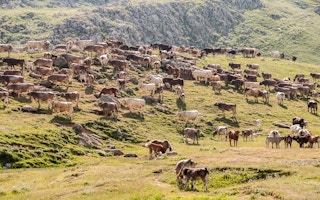Overgrazing and poor soil management are depriving grasslands of essential nutrients such as phosphorus, a study warns.
As the demand for meat and dairy grows in developing countries, grasslands need better management to produce enough animal feed such as fresh grass and hay, the researchers found.
In the paper, published last month (16 February) in Nature Communications, scientists estimate that grass growing would need to increase by 80 per cent from 2005 to 2050 to cater for the extra livestock expected on the planet.
The study focuses on phosphorus, a soil nutrient that, along with nitrogen and potassium, is essential for grass growth. The researchers estimate that the amount of phosphorus added to the soil would need to rise fourfold by 2050 — for example by applying fertilisers — to grow sufficient grass on existing grassland.
“We are ‘mining’ our grasslands in the vast majority of the world and depleting them of nutrients,” says coauthor Martin van Ittersum, an agricultural scientist at Wageningen University in the Netherlands. The role of grasslands in food production is “largely forgotten” in favour of croplands, van Ittersum says, and grasslands are “poorly fertilised” in many parts of the world, including Africa, Asia and parts of the Americas.
Farmers often remove nutrient-rich manure from grassland on which livestock graze and use it to fertilise cereal or root crop fields, he says.
Rolf Sommer, a soil health researcher at the International Center for Tropical Agriculture in Kenya, sounds a pessimistic note. “I don’t think grasslands will receive more fertiliser,” he says. “They will degrade further.” Besides, applying excessive amounts of fertiliser on the land can pollute the environment if toxic substances leach into nearby waterways, Sommer explains.
“We have to make sure that phosphorus doesn’t end up in the ocean,” van Ittersum says. “We need to maintain good plant cover [in grasslands] that prevents erosion and runoff,” and also need to avoid overstocking and ensure good rotational grazing, he adds.
According to the UN’s Food and Agriculture Organization, 26 per cent of all ice-free land is used for livestock grazing, while another 33 per cent of cropland is used to produce animal fodder. Better agricultural policies could result in more balanced fertilisation, Sommer says.
In Malawi for instance, the government could move subsidies away from widely used nitrogen-rich fertilisers in favour of phosphorus and potassium, he suggests. Another option is to lower demand for meat and dairy, but this is unlikely to bring significant improvements in developing countries, say both Sommer and van Ittersum.
“I would definitely subscribe and eat less meat to take pressure off resources, but it’s often wishful thinking,” Sommer says.










